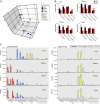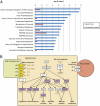Systemic gut microbial modulation of bile acid metabolism in host tissue compartments
- PMID: 20837534
- PMCID: PMC3063584
- DOI: 10.1073/pnas.1006734107
Systemic gut microbial modulation of bile acid metabolism in host tissue compartments
Abstract
We elucidate the detailed effects of gut microbial depletion on the bile acid sub-metabolome of multiple body compartments (liver, kidney, heart, and blood plasma) in rats. We use a targeted ultra-performance liquid chromatography with time of flight mass-spectrometry assay to characterize the differential primary and secondary bile acid profiles in each tissue and show a major increase in the proportion of taurine-conjugated bile acids in germ-free (GF) and antibiotic (streptomycin/penicillin)-treated rats. Although conjugated bile acids dominate the hepatic profile (97.0 ± 1.5%) of conventional animals, unconjugated bile acids comprise the largest proportion of the total measured bile acid profile in kidney (60.0 ± 10.4%) and heart (53.0 ± 18.5%) tissues. In contrast, in the GF animal, taurine-conjugated bile acids (especially taurocholic acid and tauro-β-muricholic acid) dominated the bile acid profiles (liver: 96.0 ± 14.5%; kidney: 96 ± 1%; heart: 93 ± 1%; plasma: 93.0 ± 2.3%), with unconjugated and glycine-conjugated species representing a small proportion of the profile. Higher free taurine levels were found in GF livers compared with the conventional liver (5.1-fold; P < 0.001). Bile acid diversity was also lower in GF and antibiotic-treated tissues compared with conventional animals. Because bile acids perform important signaling functions, it is clear that these chemical communication networks are strongly influenced by microbial activities or modulation, as evidenced by farnesoid X receptor-regulated pathway transcripts. The presence of specific microbial bile acid co-metabolite patterns in peripheral tissues (including heart and kidney) implies a broader signaling role for these compounds and emphasizes the extent of symbiotic microbial influences in mammalian homeostasis.
Conflict of interest statement
The authors declare no conflict of interest.
Figures




References
-
- Ley RE, Turnbaugh PJ, Klein S, Gordon JI. Microbial ecology: Human gut microbes associated with obesity. Nature. 2006;444:1022–1023. - PubMed
-
- Nicholson JK, Holmes E, Wilson ID. Gut microorganisms, mammalian metabolism and personalized health care. Nat Rev Microbiol. 2005;3:431–438. - PubMed
-
- Turnbaugh PJ, et al. An obesity-associated gut microbiome with increased capacity for energy harvest. Nature. 2006;444:1027–1031. - PubMed
Publication types
MeSH terms
Substances
Associated data
- Actions
Grants and funding
LinkOut - more resources
Full Text Sources
Other Literature Sources
Medical
Molecular Biology Databases

